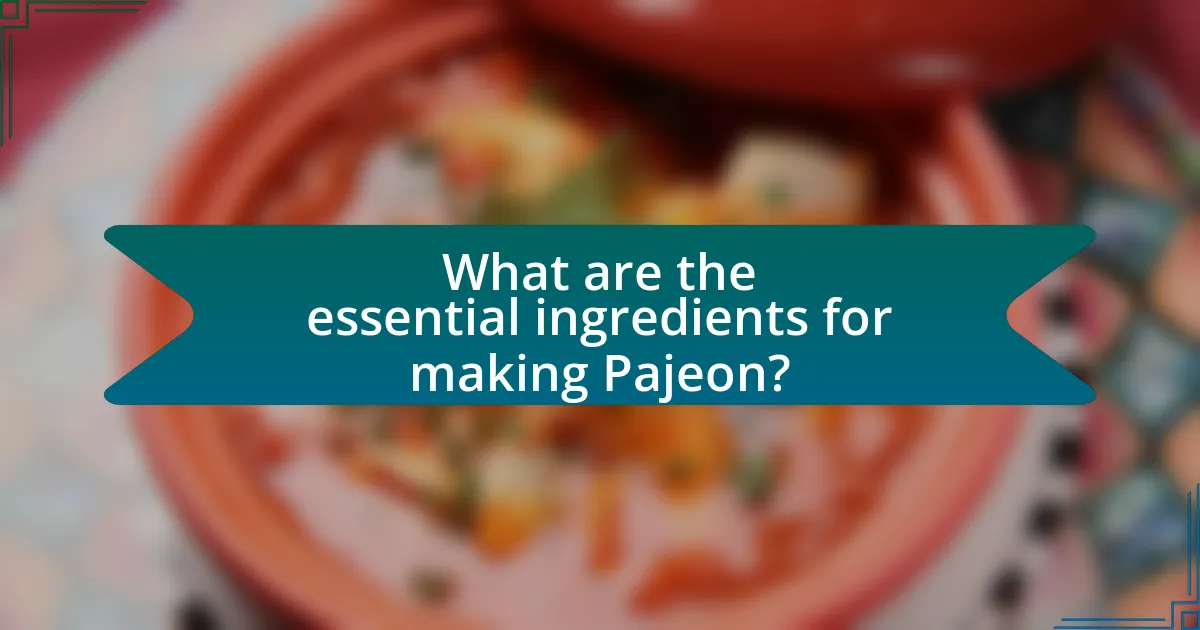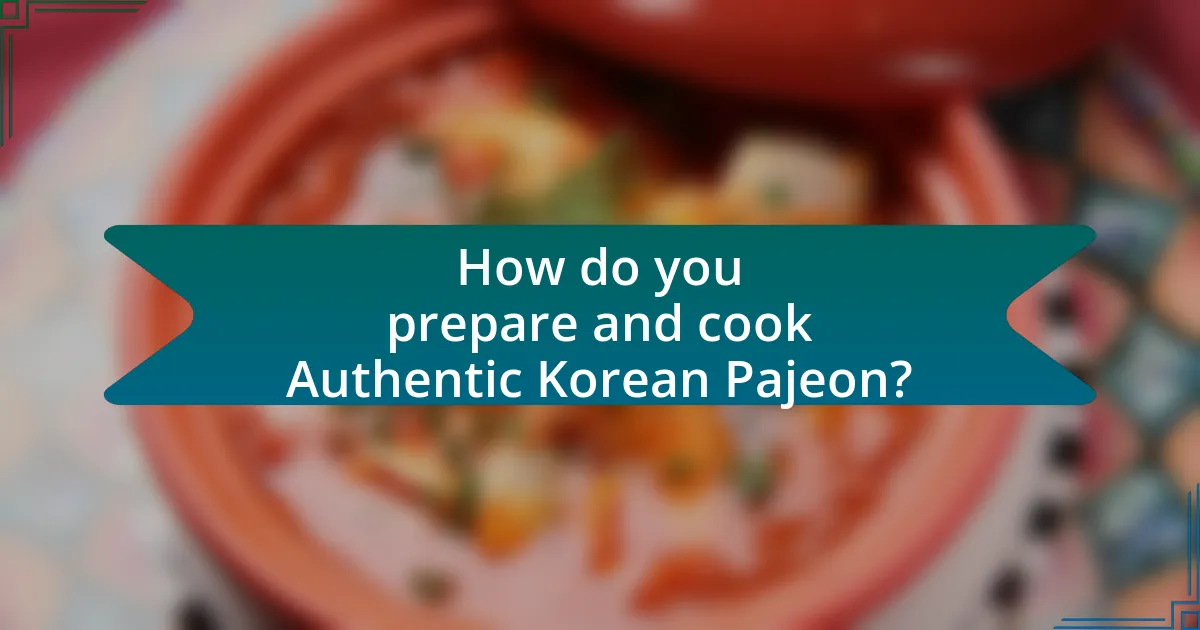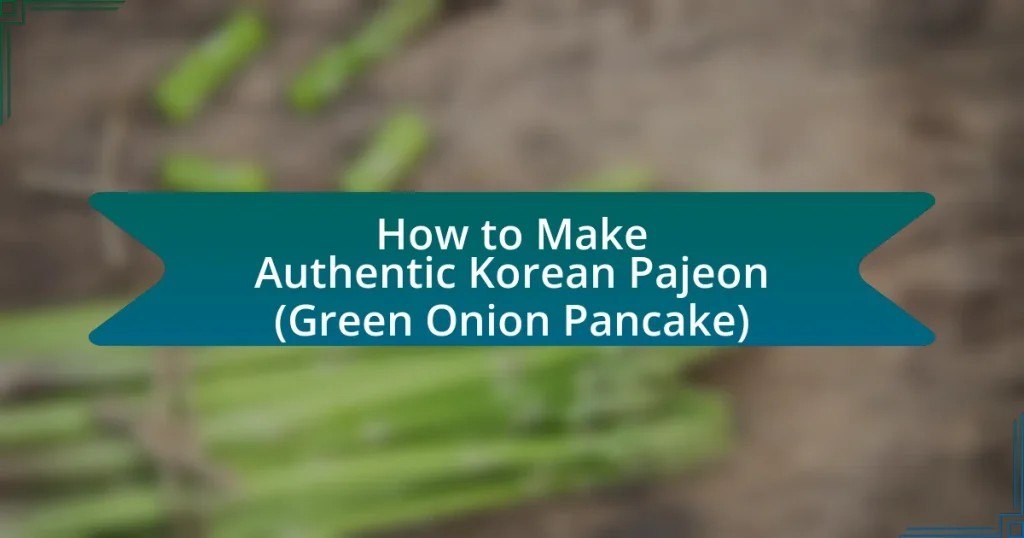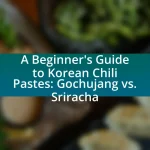Authentic Korean Pajeon, a savory pancake primarily made with wheat flour, water, and green onions, is characterized by its crispy exterior and soft interior. This dish is distinct from other Korean pancakes due to its emphasis on green onions, which contribute to its unique flavor and texture. The article explores the essential ingredients, traditional variations, and cultural significance of Pajeon, as well as detailed instructions on preparation, cooking techniques, and tips for achieving the perfect texture. Additionally, it addresses common mistakes to avoid and offers suggestions for customizing the dish to suit individual preferences.

What is Authentic Korean Pajeon?
Authentic Korean Pajeon is a savory pancake made primarily with a batter of wheat flour, water, and green onions. This dish is characterized by its crispy exterior and soft interior, often enhanced with additional ingredients like seafood or vegetables. Pajeon is traditionally enjoyed as a snack or appetizer in Korean cuisine, particularly during rainy days, and is often served with a dipping sauce made of soy sauce and vinegar.
How is Pajeon different from other Korean pancakes?
Pajeon is distinct from other Korean pancakes primarily due to its key ingredient: green onions, which are the defining feature of this dish. While other Korean pancakes, such as Kimchi Jeon or Buchimgae, may incorporate various vegetables or proteins, Pajeon specifically highlights the flavor and texture of green onions, often using them in a larger quantity. This emphasis on green onions not only influences the taste but also contributes to the pancake’s characteristic chewy texture, setting it apart from the more varied ingredients found in other types of Korean pancakes.
What ingredients make Pajeon unique?
Pajeon is unique primarily due to its key ingredients: green onions, a wheat flour batter, and various optional additions like seafood or vegetables. The green onions provide a distinct flavor and texture, while the wheat flour creates a crispy exterior when pan-fried. Traditionally, the batter is mixed with water and sometimes includes eggs for richness. The combination of these ingredients results in a savory pancake that is a staple in Korean cuisine, often enjoyed as a snack or side dish.
What are the traditional variations of Pajeon?
The traditional variations of Pajeon include Haemul Pajeon, which incorporates seafood such as shrimp and squid, and Kimchi Pajeon, which features fermented kimchi as a primary ingredient. Additionally, there is Bindaetteok, a mung bean pancake variation that can also be considered a type of Pajeon. These variations highlight the versatility of Pajeon, allowing for different flavors and textures based on the ingredients used.
Why is Pajeon a popular dish in Korean cuisine?
Pajeon is a popular dish in Korean cuisine due to its unique flavor profile and versatility as a savory pancake. This dish combines a simple batter of flour and water with green onions and other ingredients, making it easy to prepare and adaptable to various tastes. Pajeon is often enjoyed as a snack or appetizer, and its crispy texture paired with a dipping sauce enhances its appeal. Additionally, it holds cultural significance, often served during rainy days or as a communal dish, which further contributes to its popularity in Korean dining traditions.
What occasions is Pajeon typically served for?
Pajeon is typically served during rainy days, celebrations, and gatherings. In Korean culture, the dish is often enjoyed as a comfort food on rainy days due to its warm and savory nature. Additionally, it is commonly prepared for special occasions such as birthdays and holidays, where it symbolizes good fortune and prosperity. The association with gatherings stems from its popularity as a shared dish among friends and family, enhancing the communal dining experience.
How does Pajeon reflect Korean culinary traditions?
Pajeon reflects Korean culinary traditions through its use of simple, locally sourced ingredients and its communal eating style. This savory pancake, primarily made with green onions, embodies the Korean principle of utilizing fresh produce and seasonal ingredients, which is a hallmark of traditional Korean cooking. Additionally, Pajeon is often enjoyed during gatherings or rainy days, emphasizing the cultural importance of sharing food and creating a sense of community in Korean society. The dish’s preparation and consumption highlight the significance of togetherness and the enjoyment of food as a social experience in Korean culture.

What are the essential ingredients for making Pajeon?
The essential ingredients for making Pajeon are all-purpose flour, water, green onions, and salt. All-purpose flour serves as the base for the batter, while water is mixed in to achieve the desired consistency. Green onions are the primary flavor component, providing the characteristic taste of Pajeon, and salt enhances the overall flavor. These ingredients combine to create a savory pancake that is a staple in Korean cuisine.
What type of flour is best for Pajeon?
The best type of flour for Pajeon is a combination of all-purpose flour and rice flour. This blend creates a crispy texture while maintaining a chewy consistency, which is essential for authentic Pajeon. All-purpose flour provides structure, while rice flour enhances the crispiness, making the pancake light and airy. This combination is commonly used in traditional recipes to achieve the desired texture and flavor profile.
How does the choice of flour affect the texture of Pajeon?
The choice of flour significantly affects the texture of Pajeon, as different flours yield varying levels of chewiness and crispiness. For instance, using all-purpose flour results in a balanced texture that is both tender and slightly chewy, while a higher protein flour, such as bread flour, creates a denser and chewier pancake. Conversely, using rice flour or a combination of rice flour and wheat flour can produce a lighter, crispier texture due to the unique properties of rice flour, which absorbs less moisture. This variation in flour types directly influences the final mouthfeel and structural integrity of the Pajeon, making flour selection crucial for achieving the desired texture.
What role do green onions play in the flavor of Pajeon?
Green onions are essential in enhancing the flavor of Pajeon, contributing a fresh, mild onion taste that balances the dish’s savory elements. Their presence adds a distinct aromatic quality, which complements the batter and other ingredients, creating a harmonious flavor profile. The green onions also provide a slight crunch, adding texture to the pancake, which is crucial for the overall eating experience.
What additional ingredients can enhance Pajeon?
Mushrooms, seafood, and kimchi can enhance Pajeon. Adding shiitake or enoki mushrooms provides umami flavor, while incorporating shrimp or squid introduces a seafood element that complements the pancake’s texture. Kimchi adds a spicy and tangy kick, enriching the overall taste profile. These ingredients are commonly used in traditional recipes, demonstrating their effectiveness in elevating the dish.
How can seafood be incorporated into Pajeon?
Seafood can be incorporated into Pajeon by adding ingredients such as shrimp, squid, or clams directly into the batter before cooking. These seafood options enhance the flavor and texture of the pancake, making it more savory and appealing. For instance, using about 100 grams of chopped shrimp or squid mixed with the batter allows the seafood to cook evenly and infuse its taste into the Pajeon. This method is commonly practiced in Korean cuisine, where seafood Pajeon is a popular variation, showcasing the versatility of the dish.
What are some popular dipping sauces for Pajeon?
Some popular dipping sauces for Pajeon include soy sauce mixed with vinegar, sesame oil, and gochujang (Korean chili paste). Soy sauce combined with vinegar provides a tangy flavor that complements the savory pancake, while sesame oil adds a nutty richness. Gochujang can be mixed with soy sauce for a spicy kick, enhancing the overall taste experience. These sauces are commonly used in Korean cuisine and are well-known for their ability to elevate the flavors of dishes like Pajeon.

How do you prepare and cook Authentic Korean Pajeon?
To prepare and cook authentic Korean pajeon, start by mixing 1 cup of all-purpose flour, 1 cup of water, and a pinch of salt in a bowl to create a batter. Then, add 1 cup of chopped green onions and any additional ingredients like seafood or vegetables as desired. Heat a non-stick skillet over medium heat and add a tablespoon of vegetable oil. Pour half of the batter into the skillet, spreading it evenly, and cook for about 3-4 minutes until the bottom is golden brown. Flip the pancake and cook for another 3-4 minutes until both sides are crispy. Repeat with the remaining batter. Authentic pajeon is characterized by its crispy texture and savory flavor, making it a popular dish in Korean cuisine.
What are the steps to prepare the batter for Pajeon?
To prepare the batter for Pajeon, combine flour, water, and salt in a mixing bowl. First, measure one cup of all-purpose flour and add it to the bowl. Next, pour in one cup of cold water and mix until the batter is smooth and free of lumps. Then, add half a teaspoon of salt to enhance the flavor. This mixture creates a thin batter that is essential for achieving the desired texture of the pancake.
How do you achieve the right consistency for the batter?
To achieve the right consistency for the batter in Korean Pajeon, combine equal parts of flour and water, typically using a ratio of 1:1. This ratio ensures a smooth, pourable batter that adheres well to the green onions while allowing for a crispy texture when cooked. Adjust the water slightly if the batter appears too thick or too thin, aiming for a consistency similar to heavy cream. This method is validated by traditional recipes that emphasize the importance of balance between flour and water for optimal texture and flavor in Pajeon.
What techniques can improve the flavor of the batter?
To improve the flavor of the batter for Korean Pajeon, incorporating ingredients such as finely chopped scallions, garlic, and a splash of soy sauce enhances the taste profile significantly. The addition of scallions provides a fresh, aromatic quality, while garlic adds depth and complexity. Soy sauce contributes umami, balancing the flavors. Additionally, using cold water or sparkling water in the batter creates a lighter texture, which can enhance the overall eating experience. These techniques are supported by traditional recipes that emphasize the importance of fresh ingredients and proper texture for optimal flavor.
What is the best method for cooking Pajeon?
The best method for cooking Pajeon is to use a hot skillet with a combination of oil and a well-prepared batter. Start by mixing flour, water, and chopped green onions to create a smooth batter. Heat the skillet over medium-high heat, add oil, and pour in the batter, spreading it evenly. Cook until the edges are crispy and the bottom is golden brown, then flip to cook the other side. This method ensures a crispy texture and even cooking, which is essential for authentic Pajeon.
How do you ensure a crispy texture when frying Pajeon?
To ensure a crispy texture when frying Pajeon, use a high ratio of flour to water in the batter and fry in hot oil. A thicker batter creates a crunchier exterior, while the hot oil helps achieve that desired crispiness quickly. Additionally, using a cast-iron skillet retains heat well, promoting even frying and browning. The combination of these techniques results in a Pajeon that is crispy on the outside and tender on the inside.
What tips can help in flipping Pajeon without breaking it?
To flip Pajeon without breaking it, use a wide spatula to support the entire pancake during the flip. This technique minimizes the risk of breakage by distributing the weight evenly. Additionally, ensure that the Pajeon is cooked thoroughly on one side before attempting to flip; a well-cooked base will hold together better. Using a non-stick pan and sufficient oil also aids in preventing sticking, which can lead to tearing. These methods are effective because they address the structural integrity of the pancake and reduce friction during the flipping process.

What are some common mistakes to avoid when making Pajeon?
Common mistakes to avoid when making Pajeon include using too much water in the batter, which can lead to a soggy texture. Additionally, not allowing the pan to heat sufficiently before adding the batter can result in uneven cooking and a lack of crispiness. Failing to use a non-stick pan or enough oil can also cause the pancake to stick and break apart. Lastly, overcrowding the pan with too many ingredients can prevent proper cooking and browning. These factors are crucial for achieving the desired texture and flavor of authentic Pajeon.
What are the pitfalls in ingredient selection for Pajeon?
The main pitfalls in ingredient selection for Pajeon include using low-quality flour, selecting the wrong type of green onions, and neglecting the balance of wet and dry ingredients. Low-quality flour can lead to a dense texture, while the use of scallions instead of green onions can alter the flavor profile significantly. Additionally, improper ratios of water to flour can result in a pancake that is either too soggy or too dry, affecting the overall taste and consistency. These factors are crucial for achieving the authentic texture and flavor characteristic of traditional Pajeon.
How can improper cooking techniques ruin Pajeon?
Improper cooking techniques can ruin Pajeon by leading to a soggy texture and uneven cooking. For instance, using too much batter or insufficient heat can prevent the pancake from crisping up, resulting in a dense and unappetizing dish. Additionally, flipping the Pajeon too early can cause it to break apart, compromising its structural integrity. Cooking at the wrong temperature can also lead to burnt edges while leaving the center undercooked, which detracts from the overall flavor and experience of this traditional Korean dish.
What should you watch out for when serving Pajeon?
When serving Pajeon, you should watch out for its temperature and texture. Pajeon is best enjoyed hot and crispy, so ensure it is served immediately after cooking to maintain its ideal consistency. Additionally, be cautious of the dipping sauce, as it can overpower the delicate flavors of the pancake; a light soy sauce with vinegar is recommended to complement rather than mask the taste.
What tips can enhance your Pajeon-making experience?
To enhance your Pajeon-making experience, use fresh ingredients, particularly green onions, as their quality directly affects the flavor and texture of the pancake. Incorporating a mix of flours, such as all-purpose and rice flour, can improve the crispiness, as rice flour creates a lighter texture. Additionally, ensuring the batter is not too thick allows for even cooking and better incorporation of the vegetables. Cooking on medium-high heat helps achieve a golden-brown crust while keeping the inside tender. Finally, serving Pajeon with a dipping sauce made of soy sauce, vinegar, and sesame oil elevates the overall taste, making the dish more authentic and enjoyable.
How can you customize Pajeon to suit your taste preferences?
You can customize Pajeon by adjusting the ingredients to match your taste preferences, such as varying the types of vegetables, proteins, or seasonings used. For instance, you can add ingredients like shrimp, squid, or mushrooms for different flavors and textures. Additionally, you can modify the batter by incorporating different flours, such as whole wheat or rice flour, to change the texture. Seasoning the batter with ingredients like garlic, ginger, or chili flakes can also enhance the flavor profile. These adjustments allow for a personalized Pajeon that caters to individual tastes while maintaining the dish’s authentic characteristics.
What are some best practices for storing leftover Pajeon?
To store leftover Pajeon effectively, place it in an airtight container to maintain freshness. This method prevents moisture loss and keeps the texture intact. Additionally, refrigerate the container to extend the shelf life, as Pajeon can last up to three days when properly stored. For longer storage, consider freezing the Pajeon, which can preserve its quality for up to two months. When reheating, use a skillet to restore its crispiness, ensuring a better taste and texture.


